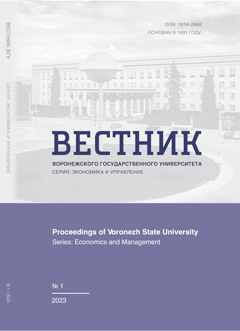Структура капитала эмитента и корпоративное мошенничество в анализе риска на рынке облигаций: свидетельства с Мосбиржи
Аннотация
Предмет: кризисные периоды в экономике ставят перед участниками рынка облигаций новые вызовы. Один из таких вызовов связан с качеством информации о деятельности эмитентов, предоставляемой стейкхолдерам.
Цель: идентификация ценовых аномалий на рынке рублевых облигаций, обусловленных склонностью корпоративных эмитентов к фальсификации информации, раскрываемой в отчетности, а также структурой капитала эмитентов.
Методы: в исследовании рассматривается группа из четырех рабочих гипотез о влиянии структуры капитала и склонности эмитента к корпоративному мошенничеству в отношении фальсификации отчетной информации. Для тестирования каждой гипотезы были сформированы специальные портфели облигаций и вычислена их избыточная доходность. Само тестирование осуществлялось в двух вариантах: без учета факторов систематического риска и с учетом факторов кредитного и процентного рисков в рамках процедуры кросс-секционного анализа избыточной доходности. Аналитические процедуры проводились в среде разработки RStudio. Выборочная совокупность охватывает период с января 2011 по декабрь 2022 г.
Результаты: на российском рынке облигаций были выявлены статистически значимые премии за риск неоптимальной структуры капитала эмитента, т. е. структуры капитала с ничтожной либо крайне высокой долей заемного капитала. Информация о склонности к фальсификации корпоративной отчетности учитывается в показателях доходности и риска облигаций. Кроме того, избыточные доходности тестируемых портфелей в значительной степени обусловлены фазой делового цикла.
Выводы: владельцы рублевых корпоративных облигаций демонстрируют ограниченную рациональность в оценках риска фальсификации отчетной информации корпоративными эмитентами с позиции гипотез, закладываемых в индикаторы риска в модели Beneish. Можно утверждать, что рынок рублевых корпоративных облигаций неэффективен в отношении информации о возможной фальсификации отчетной информации. Соответствующие ценовые аномалии могут быть использованы для формирования прибыльных портфельных стратегий на рынке российских корпоративных облигаций.
Metrics
Литература
Acharya, V. V., Amihud, Y., Bharath, S. T. (2013). Liquidity risk of corporate bond returns: Conditional approach. Journal of Financial Economics, 2 (110), 358-386.
Allozi, N. M., Obeidat, G. S. (2016). The Relationship between the Stock Return and Financial Indicators (Profitability, Leverage): An Empirical Study on Manufacturing Companies Listed in Amman Stock Exchange. Journal of Social Sciences, 5(3), 408-424.
Arditti, F. D. (1967). Risk and Return on Equity. Journal of Finance, 22(1), 19-36.
Beneish, M. D. (1999). The Detection of Earnings Manipulation. Financial Analysts Journal, 5(55), 24-36.
Beneish, M. D., Farber, D. B., Glendening, M., Shaw, K. W. (2023). Aggregate Financial Misreporting and the Predictability of U.S. Recessions and GDP Growth. The Accounting Review, 98(5). 129-159. https://doi.org/10.2308/TAR-2021-0160
Beneish, M. D., Lee, C. M. C., Nichols, D. C. (2013). Earnings manipulation and expected returns. Financial Analysts Journal, 69(2), 57-82.
Bhandari, L. C. (1988). Debt/Equity Ratio and Expected Common Stock Returns: Empirical Evidence. Journal of Finance, XLIII, 507-528.
Bhatt, V., Sultan, J. (2012). Leverage Risk, Financial Crisis, and Stock Returns: A Comparison Among Islamic, Conventional, and Socially Responsible Stocks. Islam. Econ. Stud, 20, 87-119.
Dickerson, A., Mueller, P., Robotti, C. (2023). Priced risk in corporate bonds. Journal of Financial Economics, 150(2), 103707. https://doi.org/10.1016/j.jfineco.2023.103707
Dimitrov, V., Jain, P. C. (2005). The Value Relevance of Changes in Financial Leverage. SSRN. http://dx.doi.org/10.2139/ssrn.708281
Endovitsky, D. A., Korotkikh, V. V., Khripushin, D. A. (2021). Equity risk and return across hidden market regimes. Risks. 9(11), 188. https://doi.org/10.3390/risks9110188.
Fama, E., French K. (1993). Common risk factors on stocks and bonds. Journal of Financial Economics, 33(1), 3-56. https://doi.org/10.1016/0304-405X(93)90023-5
Jaroszek, L., Niessen-Ruenzi, A., Ruenzi, S. (2018). Corporate Fraud Risk and Stock Market Performance. SSRN Electronic journal. URL: https://dx.doi.org/10.2139/ssrn.2636633
Penman, S. H., Richardson, S. A., Tuna, I. (2007). The Book-to-Price Effect in Stock Returns: Accounting for Leverage. Journal of Accounting Research, 45(2), 427-467.
Ullah, I., Shah, A. (2014). The Effect of Capital Structure on Abnormal Stock Returns: Evidence from Pakistan. Business & Economic Review, 6, 1-18.
Ендовицкий, Д. А., Коротких, В. В. (2022). Оценка влияния масштабов национальных фондовых рынков и различных кризисных явлений в экономике на уровень рисков операций с финансовыми инструментами. Вестник ВГУ. Серия: Экономика и управление, (1), 3-27. [Endovitsky, D. А., Korotkikh, V. V. (2022). Regime shifts in equity risk premium: international evidence. Proceedings of Voronezh State University. Series: Economics and Management, (1), 3-27. (In Russian).] https://doi.org/10.17308/econ.2022.1/3842
Коротких, В. В. (2022). Сравнительный статистический анализ структуры премии за риск на фондовых рынках разных стран. Вестник ВГУ. Серия: Экономика и управление, (2), 83-98. [Korotkikh, V. V. (2022). Term structure of risk factor premiums: evidence from international equity markets. Proceedings of Voronezh State University. Series: Economics and Management, (2), 83-98. (In Russian).] https://doi.org/10.17308/econ.2022.2/8989
Коротких, В. В. (2023). Риск искажения финансовой отчетности и доходность корпоративных облигаций: свидетельства с Московской биржи. Финансы и кредит, 29(12), 2813-2840. [Korotkikh, V. V. (2023). Corporate fraud, inertia and market conditions in explaining the differences in the exchange characteristics of bonds in the Russian market. Finance and Credit, 29(12), 2813-2840. (In Russian).] https://doi.org/10.24891/fc.29.12.2813
Теплова, Т. В., Соколова, Т. В. (2017). Непараметрический метод оболочечного анализа для портфельных построений на российском рынке облигаций. Экономика и математические методы, 53(3), 110-128. [Teplova, T.V., Sokolova, T.V. (2017). The non-parametric data envelopment analysis method for portfolio design in the Russian bond market. Economics and Mathematical Methods, 53(3), 110-128. (In Russian).]
Ферулева Н. В., Штефан М. А. (2016). Выявление фактов фальсификации финансовой отчетности в российских компаниях: анализ применимости моделей Бениша и Роксас. Российский журнал менеджмента, 14(3), 49-70. [Feruleva N.V., Shtefan М.А. (2016). Detection of Financial Statements Fraud in Russian Companies: Analysis of the Beneish and Roxas Models Applicability. Russian Management Journal, 14(3), 49-70. (In Russian.)]

Это произведение доступно по лицензии Creative Commons «Attribution» («Атрибуция») 4.0 Всемирная.























